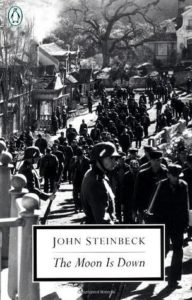One of my most vivid memories of middle school was carrying a paperback copy of The Red Pony by John Steinbeck. It was required reading in eighth grade, along with Ernest Hemingway’s The Old Man and the Sea and several others. Our reading teacher also assigned our class to read The Lord of the Flies by William Golding, but parents objected. We did what all good 13-year-old boys would do in such a situation: we read it on our own.
Steinbeck’s novella was popular. The four connected stories, about a boy growing up on a ranch, were easy to read. The teacher encouraged us to read more of Steinbeck outside of class, and a few of us did, tackling Tortilla Flat and The Grapes of Wrath (which was not as easy to read as The Red Pony).
Steinbeck (1902-1968) published a series of fictional works considered American classics, including Cannery Row, Of Mice and Men, and East of Eden. He’s best remembered for The Grapes of Wrath, which won the Pulitzer Prize for fiction and the National Book Award in 1940.

John Steinbeck
It was in 1940 that Steinbeck became concerned with the Nazi German threat. Europe was at war, and Nazi propaganda was flourishing in the United States and Latin America. Steinbeck was particularly disturbed by how good the propaganda was; he met with President Franklin Roosevelt to express his concerns but thought nothing had come of it … Until the next year, when he was contacted by the agency that became the Central Intelligence Agency to write propaganda from the opposite perspective. He set to work, and produced a short novel called The Moon Is Down, published in 1942.
Without ever mentioning the country in which it is set, or the name of the invading and occupying country, Steinbeck told a story of a small town having to confront the reality of occupation. Most readers sensed he was writing about Norway, but everyone knew the occupying power was Nazi Germany. It is a story of ordinary people caught up in extraordinary events, moving from shock to resentment and ultimately resistance.
The American reading public liked the book, but it was savaged by two of the leading literary critics of the day, Clifton Fadiman and James Thurber. It’s admittedly not among Steinbeck’s best work. It seems wooden and stilted in places, although it also contains some absolute gems of writing. “Uneven” is how many might describe it today.
But that’s only part of the story of The Moon Is Down. The other part is what happened outside the United States.

In the U.S., one of the criticisms was that Steinbeck had made the occupying soldiers seem like ordinary people instead of “Nazi monsters.” Readers in occupied countries saw that as entirely realistic, resonating with their own experience of what German soldiers were like. Yes, there was brutality and violence, but the soldiers seemed like ordinary, recognizable people. That was part of the horror of the experience.
And that was the key to the novel’s profound reception. After the war, people would say over and over again how well Steinbeck had captured the experience of occupation, as if he had been there. The book offered understanding of a terrible experience; it also offered hope and a reason for people to risk their lives to fight the occupation.
The Moon Is Down also explains why democracy is the best form of government, what freedom is, and what the cost can be.
Photo by Hannes Flo, Creative Commons, via Flickr. Post by Glynn Young.
__________________________

“I require all our incoming poetry students—in the MFA I direct—to buy and read this book.”
—Jeanetta Calhoun Mish
- Longfellow’s “Paul Revere’s Ride”: Creating a National Legend - April 17, 2025
- Poets and Poems: Katie Kalisz and “Flu Season” - April 15, 2025
- Poets and Poems: Michelle Ortega and “When You Ask Me, Why Paris?” - April 10, 2025

Bethany R. says
How interesting. I read The Old Man and the Sea in 9th grade, and I remember being gripped by it. That caused me to buy The Grapes of Wrath with my own money, which I only got half-way through (maybe I’d like it more as an adult). But I wasn’t familiar with this one. Thanks for explaining a bit about it and its context.
Megan Willome says
What a history! I need to read it.
My favorite Steinbeck is “Of Mice and Men.’
sarongi says
loved this review. i just watched Cherry, and don’t know but the horrors of war resonates with me right now. thank you for helping this novel surface. will read. x
Sandra Heska King says
Placed on library hold…as part of a collection of other of his short novels that I must have read but don’t remember. What a history!
L.L. Barkat says
Fascinating. Truly.
I love when you bring these forgotten classics to us!